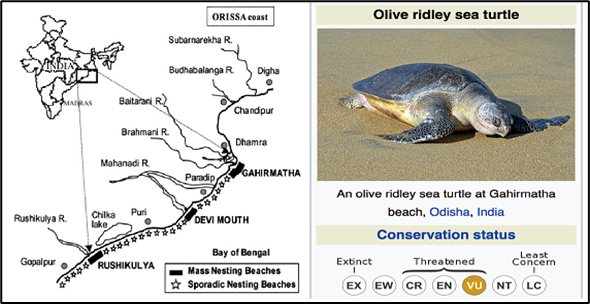Why in News?
- Since early January, a group of locals have photographed as many as 70 Olive Ridley turtles which have been found dead in their breeding grounds between Kakinada and Antarvedi in the Godavari region of Andhra Pradesh.
What’s in Today’s Article?
- Olive ridley turtles: What are they?
- What are the Breeding Grounds of Olive Ridley in India?
- News Summary with respect to the Mass Mortality of Olive Ridleys in India
Olive ridley turtles: What are they?
- They (Scientific Name: Lepidochelys olivacea) are the smallest and most abundant of all sea turtles found in the world, inhabiting warm waters of the Pacific, Atlantic and Indian oceans.
- These turtles are best known for their unique mass nesting called Arribada, where thousands of females come together on the same beach to lay eggs.
- Though found in abundance, their numbers have been declining over the past few years, and the species is recognized as Vulnerable by the IUCN Red list.
- The turtles' olive-coloured carapace (heart-shaped and rounded) gives them their name and they are carnivores that feed mainly on jellyfish, shrimp, snails, crabs, molluscs, etc.
- These turtles spend their entire lives in the ocean, and migrate thousands of kms between feeding and mating grounds in the course of a year.
- They face serious threats across their migratory route, habitat and nesting beaches, due to human activities such as -
- Turtle unfriendly fishing practices such as the accidental killing of adult turtles through entanglement in trawl nets and gill nets.
- Poaching for their meat, shell, leather and their eggs. This is despite the fact that international trade in these turtles and their products is banned under CITES Appendix I.
- Development and exploitation of nesting beaches for ports and tourist centres.
What are the Breeding Grounds of Olive Ridley in India?
- The Olive Ridely Turtles come to the beaches of Odisha coast annually between November and December and stay on until April and May for nesting.
- The turtles choose the narrow beaches near estuaries and bays for laying their eggs.

News Summary with respect to the Olive Ridleys in India:
- Mass mortality of Olive Ridleys:
- The breeding grounds between Kakinada and Antarvedi have been witnessing the mass mortality of the turtles over the past few weeks.
- This is mainly attributed to the effluents that are discharged from the aqua ponds along the coast and the discharges from the pipelines of the onshore oil exploration sites.
- A complaint had also been filed in the National Green Tribunal (NGT) against the marine and groundwater pollution in the Konaseema region.
- Other threats to Olive Ridleys:
- Operation of fishing boats in the ecologically sensitive rookery (a breeding colony) zone along the 30-km coastline in the Godavari estuary which includes the Coringa Wildlife Sanctuary and Hope Island.
- What are the steps for safe breeding and conservation of Olive Ridleys?
- Legal protection: They are legally protected under Schedule I of the Wildlife Protection Act, 1972.
- Setting up of rookeries (a group of nesting rooks): To ensure safe breeding and collect eggs through the ex-situ conservation method.
- Fencing off the nesting area and patrolling it: WWF-India, along with the fishermen community, has been involved in protecting the mass nesting site at Rushikulaya, Orissa.
- Turtle Excluder Devices (TEDs): The Orissa government has made it mandatory for trawls to use TEDs - a net designed to allow the turtles to escape while retaining the catch.
- Operation Olivia: As the nesting period stretches over six months, the Indian Coast Guard undertakes the Olive Ridley Turtle protection program every year.










